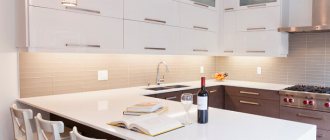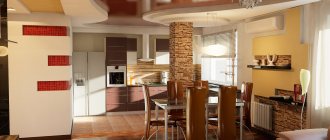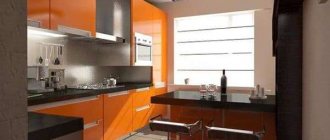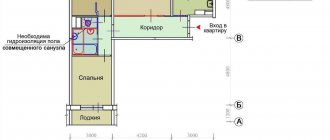To remodel a kitchen, general principles are used, which should be followed based on current legislation, as well as following the requirements of supervisory authorities.
Dear readers! The article talks about typical ways to resolve legal issues, but each case is individual. If you want to find out how to solve your particular problem , contact a consultant:
+7 (499) 938-81-90 (Moscow)
+7 (812) 467-32-77 (Saint Petersburg)
8 (800) 301-79-36 (Regions)
APPLICATIONS AND CALLS ARE ACCEPTED 24/7 and 7 days a week.
It's fast and FREE !
But there are also cases when remodeling a kitchen becomes impossible due to non-compliance with several rules.
Standard Rules
Apartments in old houses usually have an unusual layout, in which the living rooms have a large area, while the kitchen is only a few square meters.
For a modern person, such an area cannot be comfortable, since neither a good kitchen set nor large comfortable furniture can be placed here. To correct this situation, redevelopment is often resorted to.
Remodeling the kitchen occurs on the same basis as refurbishment of other rooms.
- You need to rely on Articles 25 and 26 of the Housing Code.
- But for the kitchen area there is a special decree, which was issued by the Government in 2006 under number 47.
It says that the kitchen cannot be moved into the living space. It can only be located above non-residential premises.
If there is a living room or hall under the area through which it is planned to expand the kitchen, then such redevelopment is prohibited.
Kitchen arrangement: which set to include in the design project?
If a non-standard layout is planned, it is better to order furniture - this way there is a greater chance of obtaining the optimal ratio of storage areas and work surfaces. A built-in kitchen is a convenient solution for those who value compact and unobtrusive placement of auxiliary objects. If it is necessary to isolate the set from the corridor or living room, plasterboard walls are installed even at the renovation stage.
To ensure that there is no clutter in the future kitchen-studio, when designing the redevelopment, you need to provide space for a spacious furniture set with a large number of drawers. To do this, you need to make a list in advance of items, dishes, appliances, containers and accessories that will need to be kept somewhere during periods of downtime. Then, when drawing the design, you will be able to accurately fit shelves and cabinets of the required height and in the required quantity.
What the law prohibits
The greatest restrictions regarding the redevelopment of premises in the legislation concern the kitchen. These are:
- dismantling or rebuilding ventilation shafts;
- reinstallation of the gas stove by more than 100 centimeters, unless permission has been obtained from the gas service;
- combine a kitchen with gas equipment with a living room;
- install gas pipes inside the walls;
- increase due to the bathroom (allowed for apartments located on the top floor);
- if the apartment is on the second or higher floors, then the kitchen cannot be moved to the place of the living space;
- It is forbidden to make an entrance door from the bathroom to the kitchen;
- It is prohibited to move it into a living room if it is located above the living space of the lower floor.
Moving equipment other than a gas stove within the same room can be done without approval, since this procedure is not a redevelopment.
Subtleties of organizing a kitchen renovation
In a studio-type interior, a mixture of various style trends is actively used. When designing the redevelopment of a small kitchen of 6 sq. It’s easiest to lay out a Scandinavian minimalist design with elements of high-tech hi-tech.
It is necessary to avoid visual overload of the space; the optimal solution is to create a neutral background finish, where furniture and textiles will become subsequent bright accents. Renovation in white, gray, bleached yellowish, blue, beige and green shades will add a feeling of spaciousness to the intimate atmosphere. For wall decoration, it is recommended to use paintable wallpaper - high-quality variations can be repainted up to 8 times.
In small-sized studios in the budget segment, the problem of a single window in combination with elongated rectangular outlines of the housing is often encountered. This layout assumes that the kitchen unit is located in the most shaded area. To create a comfortable working environment and mitigate the lack of apartment configuration, it is recommended to distribute the lighting as evenly as possible. It is imperative to provide lighting for the tabletop and use lamps with warm light throughout.
If you want to divert attention from the kitchen and display the living room in an advantageous frame, you should arrange a set with a neutral design - with a cream, white, light wood facade. A discreet apron, matched to the tone of the cabinets or walls, will fit perfectly here. The living area, in turn, is decorated with bright accents.
Is a merger possible?
Most often, the kitchen is combined with an adjacent living room into a living room.
Here you can place a kitchen set, a bar counter, as well as a sofa and a table. But this does not mean that such a merger is always legal. Indeed, in this case, you will have to demolish the wall between these two rooms, and if it turns out to be load-bearing, then dismantling it will be dangerous for the room itself.
If the house is a panel house, then you will have to limit yourself to simply making an opening between the rooms, since in such buildings all the internal walls are load-bearing.
With room
Very often, remodeling a kitchen comes down to the need to demolish a certain wall between this room and the living room.
Thus, the living room or other room becomes part of the kitchen. This can only be done if the kitchen has an electric stove and not a gas stove.
It is also prohibited to demolish load-bearing walls, since they cannot be demolished or their configuration changed.
The opening here can only be made after preliminary strengthening.
You can expand the kitchen at the expense of the living room even if there is a gas stove there, but to do this you need to install blinds between them.
Also, to avoid additional difficulties, you can simply replace the gas stove with an electric one. But this will only be possible in new buildings, since old houses are equipped with weak electrical wiring that will not be able to withstand the additional load.
Expanding the kitchen at the expense of the living room is possible only in those apartments where there are two or more rooms.
In a one-room apartment, it will be impossible to coordinate such a redevelopment, since there will not be a single living space left.
But even here you can find a way out by installing movable partitions.
corridor
The legislation of the Russian Federation does not prohibit moving the kitchen or increasing its size at the expense of the corridor.
But for this you need to follow a few rules.
- There should be natural light in the corridor. If there are no windows here, and the light does not come in from the neighboring room, then moving the kitchen here will not work.
- Ceilings and walls must be covered with materials that do not burn.
- When installing a kitchen stove, it is worth considering that you need to leave at least 1 meter of free space between it and the wall.
- The kitchen must be separated from other rooms by doors.
The main requirement is to place the kitchen above the non-residential premises of the neighbors below.
One of the options is one in which the sink for washing dishes and the stove will not be moved, but they will remain in their original places.
Loggia
It will not be possible to move the entire kitchen to the loggia, as this is prohibited by law.
The only solution would be to demolish the window sill block and install a glass partition in its place.
If such “French doors” were not installed, then the redevelopment will not be able to be coordinated or legalized.
Balcony
For a balcony, the same redevelopment rules exist as for a loggia.
It is unacceptable to move the kitchen onto it. You cannot install equipment here that will add additional load to this structure. It is also prohibited to install heating radiators.
But after dismantling the window sill block, more light will enter the room, and the useful living area will expand.
Problems with sewerage, ventilation, lighting when moving the kitchen into an apartment
Now let’s look at what moving a kitchen means for house communications.
A gas stove is an obstacle to a radical change in layout. When starting a redevelopment, it is advisable to replace the gas stove with an electric one!
Sewerage and water supply
The normal functioning of the kitchen involves ensuring the supply (transfer) of all types of household communications to a new location. Building codes require that the water supply to the dishwasher and kitchen sink, as well as the disposal of used water, must be uninterrupted (unobstructed) and constant. To supply water, old cold and hot water supply pipes are extended (extended) or new ones are laid. Laying is carried out in four ways:
- Along the walls in fines;
- Under the screed;
- Under a suspended or suspended ceiling;
- In decorative wall boxes.
It is advisable to re-lay sewer pipes in old houses. This is more technologically advanced and makes it easy to eliminate the structural differences between cast iron and plastic pipes. In new buildings this problem is solved even easier. Laying under a screed, especially at a distance of more than 3-4 meters, is not possible without installing a special pump: in order for wastewater to drain naturally, it is necessary to ensure a pipe slope of 3-5 degrees (about 3 cm per 1 linear meter of sewerage).
Wiring
To ensure sufficient illumination of the working surface and dining area, the correct and safe functioning of kitchen household electrical appliances, electrical wiring should be carried out. It must match the power consumption.
Moving a kitchen without a well-thought-out wiring design (scheme), without a reasonable choice of the type, material and cross-section of current-carrying conductors is a dangerous undertaking. Improper wiring is the cause of most fires. Therefore, the design of the electrical wiring diagram and electrical installation work must be entrusted to qualified specialists. Unlike new buildings, when remodeling old houses, it is better to completely replace the electrical wiring rather than move it.
Ventilation
Those wondering “is it possible to move the kitchen?” must be aware that a new kitchen must be equipped with ventilation. In accordance with SNiP 31-3-2003 (clause 9.7), it is entrusted with the task of removing air with substances formed during the combustion of household gas. Ventilation:
- It is connected to the old (which existed before the apartment was renovated) sealed ventilation duct, which sometimes stretches through other rooms;
- It cannot intersect with the neighbors’ ventilation, nor with the one installed in the bathroom, nor connect to the latter.
The main obstacle to installing ventilation is hiding the duct. Ways to get around are suspended ceilings, decorative boxes, grooved walls (including load-bearing ones) with holes made in them. For the latter, you will need to obtain a permit. It is advisable to equip long ventilation ducts with exhaust fans. In older houses, it is sometimes necessary to clean the ventilation ducts. In new buildings there is no such problem.
Lighting
The newly equipped kitchen should have sufficient lighting. According to SNiP 05/23/2010, the lighting standard for a kitchen room is not less than 150 Lux. According to SaNPiN2.1.2.2645-10 and SP 54.13330.2016, natural light should enter it during the day. Possible paths:
- From the street through the existing window;
- Through a fiberglass door;
- From the adjacent room through a glass partition, a partition made of glass blocks.
If the kitchen is moved to one of the former residential premises, problems with wiring and natural lighting usually do not arise. The option of moving it to a non-residential premises may cause difficulties with lighting, which will not be difficult for the designers and architects of our Redevelopment Coordination Bureau “PereplanHome” to solve. At the end of the article, we will focus on barriers that can significantly complicate permitting procedures.
Why is it impossible to combine
The kitchen cannot be combined with any rooms.
The law prohibits expanding or combining the kitchen at the expense of the bathroom or toilet.
This is due to the fact that “wet” rooms cannot be moved so that they are located above the kitchen or living room on the ground floor (there are no such prohibitions for non-residential premises).
With bath
But this does not mean that an apartment owner cannot place his kitchen under his neighbors’ bathroom. Upon approval, he may still be refused, citing worsening living conditions, but the essence of the refusal will not be determined.
Is it possible to coordinate the redevelopment of a bathroom and toilet in a Khrushchev-era building? In what case is it necessary to obtain the consent of neighbors for redevelopment? Find out here.
It is much easier to expand the kitchen at the expense of the bathroom if the apartment is located on the top or bottom floor.
Bathroom
For remodeling a kitchen at the expense of a bathroom, the same rules apply as for the bathroom - you cannot place the kitchen under the bathroom of neighbors on the top floor.
Often, to slightly enlarge the kitchen, a bathroom combination is used. This allows you to free up a few extra square meters for the kitchen.
But it will be possible to obtain permission to carry out such repairs only if the apartment is located on the top floor.
Would it be profitable to make a studio apartment out of a kitchen and a room?
Such redevelopment is justified if the housing is intended for a student, an elderly couple or a single person, newlyweds or a family without children. In other cases, combining a kitchen with a single living room may be accompanied by a decrease in the quality of life of household members.
An excellent way out of this situation is to organize space with the effect of isolating individual areas. Here, separation using mobile partitions, screens and furniture structures is relevant in order to create conditions for increased comfort in a room with the intersection of functional zones.
Nuances of reconstruction in various types of buildings
Different types of buildings have their own nuances in kitchen remodeling.
They can be associated with many factors: the presence or absence of windows, the presence of a gas or electric stove, etc.
In Khrushchev
Remodeling a kitchen in a Khrushchev-era building has its own characteristics, since usually its area does not exceed 6 square meters. meters.
- One option is to replace the doors or dismantle them. The latter can be done between the kitchen and living room. As a result, you will get one large room where you can cook and dine.
- To prevent the space of the resulting room from looking common, you can install a bar counter.
Expanding the kitchen in a building of this type is relatively simple, since Khrushchev buildings do not have a large number of internal load-bearing walls, and most often there is a simple partition between the kitchen and the room.
But it will be impossible to carry out such repairs if there is a gas stove in the kitchen. It is worth considering this point when starting redevelopment.
Brezhnevka
The situation is much more complicated with Brezhnevka, since here almost all the internal walls are load-bearing.
For this reason, it becomes impossible to demolish any partition.
To expand the space, you can make a standard opening in a load-bearing wall (no more than 90 centimeters wide), having previously reinforced it with metal products.
In a village house
To carry out redevelopment in a house in the village, you will also need to obtain all the relevant permits.
The only difference is that registering them is much easier. You just need to follow fire safety rules and not move the bathroom into the kitchen.
It is also prohibited to demolish load-bearing walls to expand the space, as this can be dangerous for the entire house.
To increase the kitchen space, you can build an extension next to it. All work must be carried out only after approval from the Housing Inspectorate and obtaining permission.
Overview of reconstruction options
Combining a functional area with an adjacent room is the most common; usually such renovations involve the living room. This is a convenient solution, as it allows you to arrange a large dining room, but it is not always feasible: in panel houses, the wall is often load-bearing and cannot be completely removed.
Adding the useful area of the balcony comes down to expanding the light opening and moving some of the furniture. If it is a loggia, additional insulation and increased useful functionality are acceptable. It is forbidden to set up a dining area in the corridor and other non-residential spaces, but direct cooking and related manipulations are permissible here.
It is prohibited to arrange living areas in the vacated kitchen area, although by law you can place a dressing room or office or workshop here. The space remaining for cooking and washing dishes must meet safety standards - have light sources, properly placed utility networks.
Features of remodeling a kitchen with a gas stove
Government Decree No. 508 prohibits combining kitchens with gas stoves with other residential premises. If the electrical communications at home allow this, the stove can be replaced with an electric one.
- In this case, you need to obtain permission from the gas service. After specialists have assessed the possibility of implementing this option, the head of the service must give consent to this.
- Energy sales employees should also evaluate the design documentation.
Only after receiving all permits can you apply for approval to the Housing Inspectorate.
Coordination
Remodeling an apartment is a complex process that requires compliance with a large number of rules.
For this reason, it is not so easy to coordinate the refurbishment of premises. It is necessary to follow safety rules and also take into account the rights of neighbors.
How to get permission
To obtain permission to remodel the kitchen, you must contact the authorities of the Ministry of Emergency Situations and the SES.
After this, specialists from these authorities should come to the apartment and assess the possibility of carrying out such repairs.
The solution to the issue is determined individually for each apartment or house.
But getting permission is much easier in such cases:
- if the apartment is on the first floor;
- if the apartment is multi-level, then the kitchen can be moved to any place except the first level;
- the kitchen can be placed above any non-residential premises (corridor, pantry, etc.);
- there are no restrictions for citizens whose apartments are located above cafes, offices or restaurants).
After receiving permits from the above-mentioned authorities, you should contact the BTI for a house plan and drafting. The approval of the redevelopment takes place at the Housing Inspectorate.
Project Features
Although the law does not say anything about the preparation of design documentation when remodeling a kitchen, the Housing Inspectorate will never allow repairs to be made without this document.
Its compilation can only be carried out by an organization that has permission from the SRO to do so.
Even for minor work that takes place in the kitchen (moving the sink to another place, etc.) it is necessary to draw up a project.
This happens because these changes must be made to the BTI plan.
Documentation
To approve kitchen remodeling, the following documents are required:
- statement;
- passport of a citizen of the Russian Federation;
- certificate of ownership of the premises;
- technical passport of housing;
- permits from the SES and the Ministry of Emergency Situations;
- project.
If you need to carry out redevelopment in an apartment that is not privately owned, you will need a social tenancy agreement and permission to carry out work from all residents of the apartment.
Placing the kitchen above the living room
The second case, when the apartment is located on the middle floor, and there are residential apartments below and above it, is the most difficult, since such a transfer is subject to more restrictions and all basic laws apply.
In such a situation, the owner may have a question: is it possible to build a kitchen above the neighbors’ living room? The above Government Resolution prohibits the placement of kitchens above living rooms, and the same applies to the bathroom, which should be located only above non-residential premises.
For residents of the middle floors there is only 1 option: moving the kitchen to a non-residential area (in the corridor, pantry, etc.). In this case, the prohibition on placing the kitchen as a toilet for the neighbors above must be taken into account, which can be circumvented using the certificate mentioned above, and all requirements for the construction of a kitchen niche must be taken into account:
- the sink and stove must be located in a non-residential premises, or remain in the area of the former kitchen;
- It is imperative that the new kitchen has ventilation and sufficient natural lighting, as well as proper waterproofing of the floor coverings;
- The area of the kitchen niche should not be less than 5 meters.
What about the situation when the living room is located above the kitchen? Departmental Construction Standards 61-89 (r) in paragraph 2.6 “Reconstruction and major repairs of residential buildings” contain design standards that prohibit the placement of kitchens with a gas stove under/above living rooms. The same prohibition is established in the Code of Rules 41-108-2004.
If the kitchen is not gasified, then such actions are possible provided that all standards are observed. In any case, it is impossible to make a decision to move the kitchen without consulting with specialists, as this threatens with a host of ensuing problems, both legal and purely domestic.
As for the third case (apartments located on the top floor), the location of the kitchen above the living room is also not allowed here. This is stated in the above-mentioned decree and SNiP, which guide the authors of house projects, which also impose a ban on placing a kitchen above the living room.
But, despite this limitation, there are also advantages due to the fact that there are no living rooms above and, accordingly, no bathrooms, so there is no threat of deterioration of one’s living conditions. For example, you can safely move the kitchen by expanding its area to include square meters of the toilet.
How to legalize after repair
If the redevelopment was carried out without approval, then it is considered illegal.
To legalize it, you will need to go to court.
The owner of the apartment will be required to provide evidence that no violations of the law or safety standards were committed during the work. Only under such circumstances will the court be able to make a positive decision.
If, during the process of legalization, the court discovered serious violations, then they will need to be eliminated or the premises returned to their previous appearance.
Timing and cost
It will take about 2-3 months to approve the redevelopment.
During this time, the housing inspection must make a decision on the possibility of carrying out such work. You also need to take into account the repair process itself, the timing of which depends on the volume and complexity of the work being carried out.
The cost also depends on many factors, including the region where the apartment is located.
On average, the cost of redevelopment approval is as follows.
| Project cost | From 20 thousand rubles |
| Obtaining a plan from BTI | From 200 rub. |
| State duty | From 2,000 rubles |
If you go to court, this will entail costs in the amount of 20 thousand rubles .
What are the dangers of unauthorized redevelopment of an apartment? Why is an interdepartmental redevelopment commission being created? Find out here.
What does the resolution on the redevelopment of premises in apartment buildings and residential buildings say? Read on.
Is legalization after renovation considered a simpler option? This is a controversial statement.
It is much easier and cheaper to obtain permission first, and only then do repairs, since legalization after redevelopment takes a lot of time and requires additional expenses.










